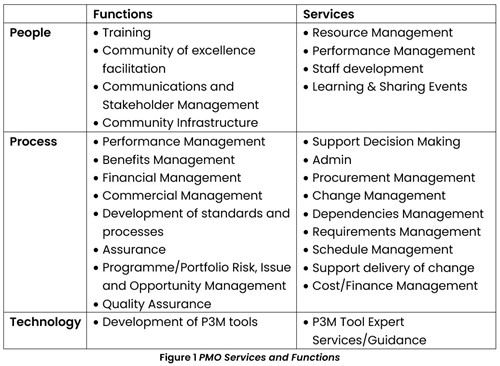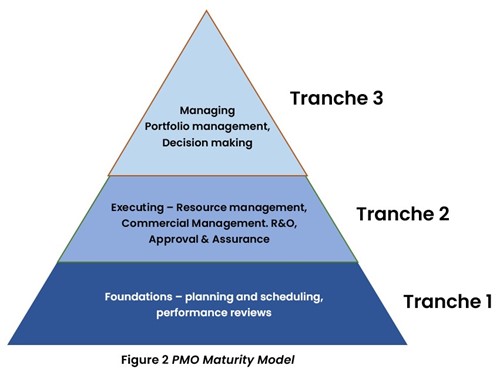Why there is no one size fits all
20 Apr 2022 01:58 PM
Why is there not a ‘one size fits all’ PMO solution? The reasons are many-fold, and we will attempt to explore a few of them here. Firstly, we will quickly address the benefits a PMO brings followed by a look at the different characteristics of PMOs and the functions and services they can provide. We will then look at how we can successfully develop, grow and operate the ‘right’ PMO for our needs.
Why PMO
Fundamentally PMOs support the delivery of change through functions and services that deliver efficiency, consistency and speedy decision making. The APM Body of Knowledge 7th edition tells us that ‘building effective within-project and cross-project support through a project, programme or portfolio management office (PMO) is critical to success’.
PMO Characteristics
PMOs can be characterised as operationally, tactically or strategically focussed:
- Operationally focused: Day-to-day tasks with an emphasis on reporting, administrative tasks and supporting processes. The PMO can influence its own internal way of working but has limited influence on other teams/functions.
- Tactically focussed: Planning, reporting, and providing advice. The PMO can influence how projects / programmes are planned and executed and exercise moderate influence how the organisation expects to conduct its activities.
- Strategically focussed: Prioritising and decision making for the organisation. The PMO can influence what, when and how an organisation conducts activities on a large scale.
PMOs are less commonly, but no less importantly, also characterised in terms of their behaviours:
- Supportive: The PMO approach is to enhance project success in existing activity and increase data & knowledge sharing across project managers (aid, empower & share)
- Controlling: The PMO establishes strong discipline across P3M activities, methods procedures and documentation. It focusses on the creation and adoption of standard methodology assures regulatory compliance and ensures projects and programmes are following standard or best practices.
- Directive: The PMO organises and tasks resources directly. Typically used when project managers formally report into the PMO, the PMO holds ownership of P3 outcomes.
In reality PMO is a combination of any of the above. The PMO should be shaped by a target operating model, a robust business process, and influenced by the prevailing business culture. Each PMO has its unique characteristics, there is no one size fits all here!
PMO Functions and Services
PMOs can provide functions and access to services that might never be justified on a single project. These functions and services can be described as broadly falling into one of three categories: People, process and technology.
Figure 1 gives an example of typical functions and services that a PMO might offer. Successful PMOs impact business and project outcomes by employing an operating model that provides the Functions that a business needs to execute projects optimally and common services to projects that enable efficient and consistent delivery by exploiting the economies of scale available.

Functions Services
People
- Training
- Community of excellence facilitation
- Communications and Stakeholder Management
- Community Infrastructure
- Resource Management
- Performance Management
- Staff development
- Learning & Sharing Events
Process
- Performance Management
- Benefits Management
- Financial Management
- Commercial Management
- Development of standards and processes
- Assurance
- Programme/Portfolio Risk, Issue and Opportunity Management
- Quality Assurance
- Support Decision Making
- Admin
- Procurement Management
- Change Management
- Dependencies Management
- Requirements Management
- Schedule Management
- Support delivery of change
- Cost/Finance Management
Technology
- Development of P3M tools
- P3M Tool Expert Services/Guidance
- Figure 1 PMO Services and Functions
Few PMOs would offer all of these and many PMOs would offer functions and services in addition to these. There is no one size fits all here either…
Developing a PMO
As with any change initiative implementing a PMO requires a strong sponsor with a clear vision of what the PMO is to achieve.
Organizations often don’t invest enough effort in developing a PMO and underestimate the time and rigour needed for both setting the vision and designing the target operating model. The temptation is always to dive straight into implementation without having a coherent view of the total capability needed. This can, and often does, result in a misaligned and inefficient operating model.
The work that goes into designing the PMO target operating model is fundamental and considers people, processes and technology aspect of the functions and services required. The effort required here to model the PMO, and the subsequent benefits shouldn’t be underestimated. Again, each PMO is different.
PMO Models
By now we have established why there is no ‘one size fits all PMO’. There are however numerous PMO models that can help us. The APM Body of Knowledge 7th edition itself refers to embedded, central and hub-and-spoke PMOs, all of which have pros and cons that must be considered prior to a design being agreed.
Ultimately though, the PMO needs to fit the vision. Defining the detail of the vision can be the difficult part of the process, requiring strong business analysis skills coupled with insight and innovation.
PMO Implementation
Anything but the simplest of PMOs really should be developed in stages or tranches like a programme due to the different streams of work that need to take place.
The target operating model should describe the functions and services available at each tranche together with the maturity of these functions and services. The staged implementation of the PMO will change the P3 environment, it is good advice to revisit and revise the target operating model on completion and maturation of each tranche. Figure 2 is a simplistic example of a staged PMO implementation.

Throughout the PMO implementation it is critical to keep the vision in mind and be wary of the law of diminishing returns. This well-known concept demonstrates that the perception of value will diminish over time regardless of the benefit a team/process/product actually adds. This phenomenon occurs because the ‘new’ thing becomes the ‘norm’.
PMO Team
Before we finish it is of course important that a the PMO is cohesive and motivated. The diverse functions and services a PMO may offer can be a barrier to a unified team spirit. It is important to select an effective PMO Lead who can find ways to produce a connected team.
Ensuring a balanced team with a mix of abilities and characteristics is a solid driver for success in the PMO, as different people can easily support different areas of the business where sub-cultures might exist.
Conclusion
One size doesn’t fit all. PMOs correctly designed can enable and bring major benefits to not only project, portfolios and programmes but also the business environment they operate within. Taking the time to develop a vision is required to identify the benefit of operating a PMO, business analysis is required to design the right PMO, and strong leadership required to establish and operate it.
This is the reason why a PMO career is so interesting, every situation is different, allowing teams and individuals to think outside the box, innovate, and bring their own unique perspective and skill to a PMO, making each journey a very personal one.
Michael Hooper and Emma-Ruth Arnaz-Pemberton
APM PMO Specific Interest Group volunteer and APM Specific Interest Group SIG chair